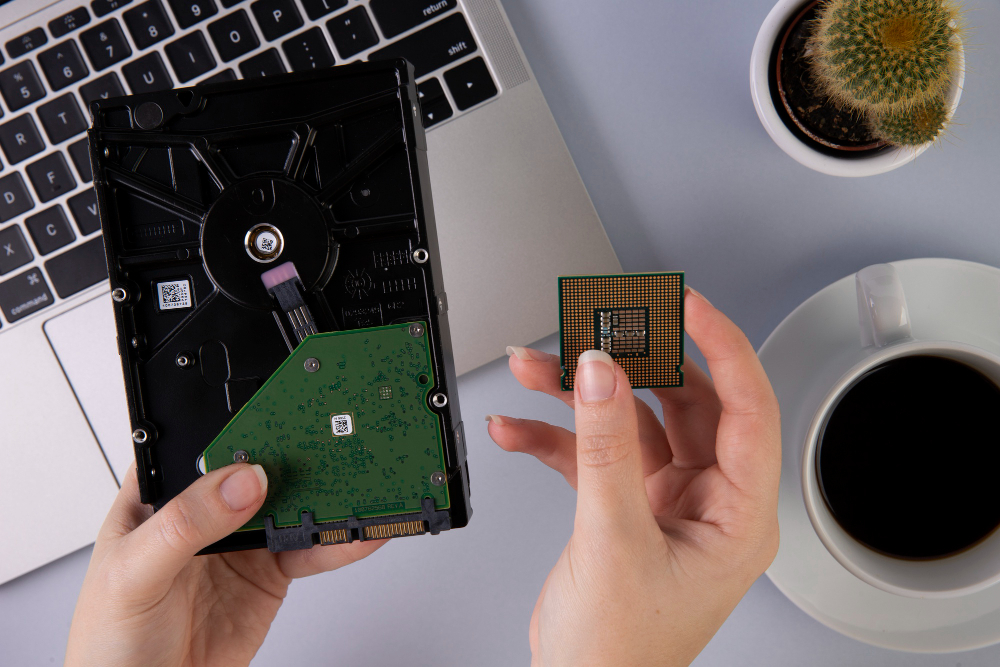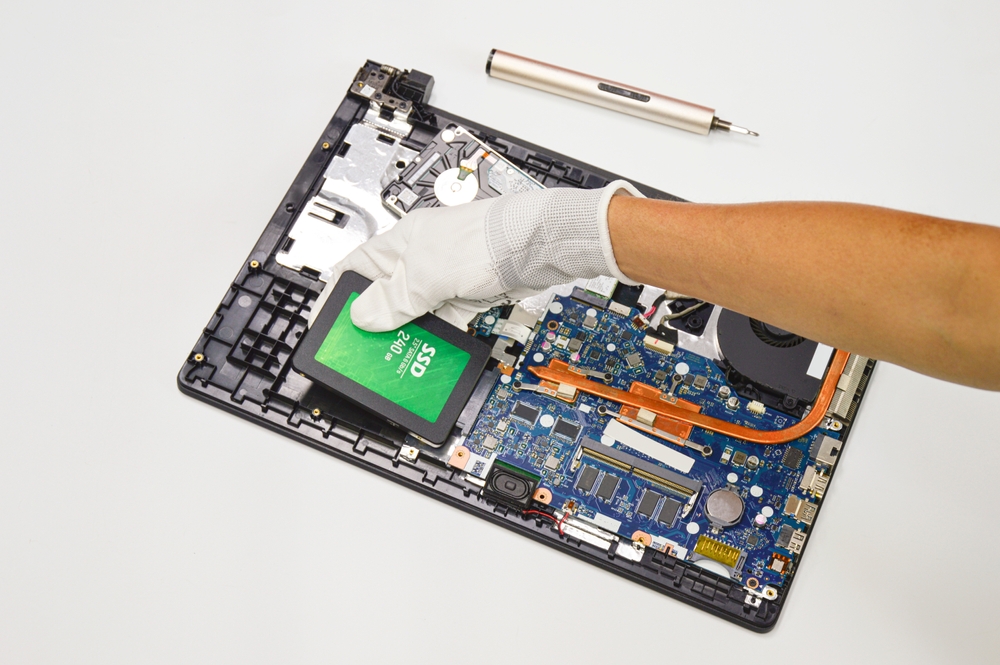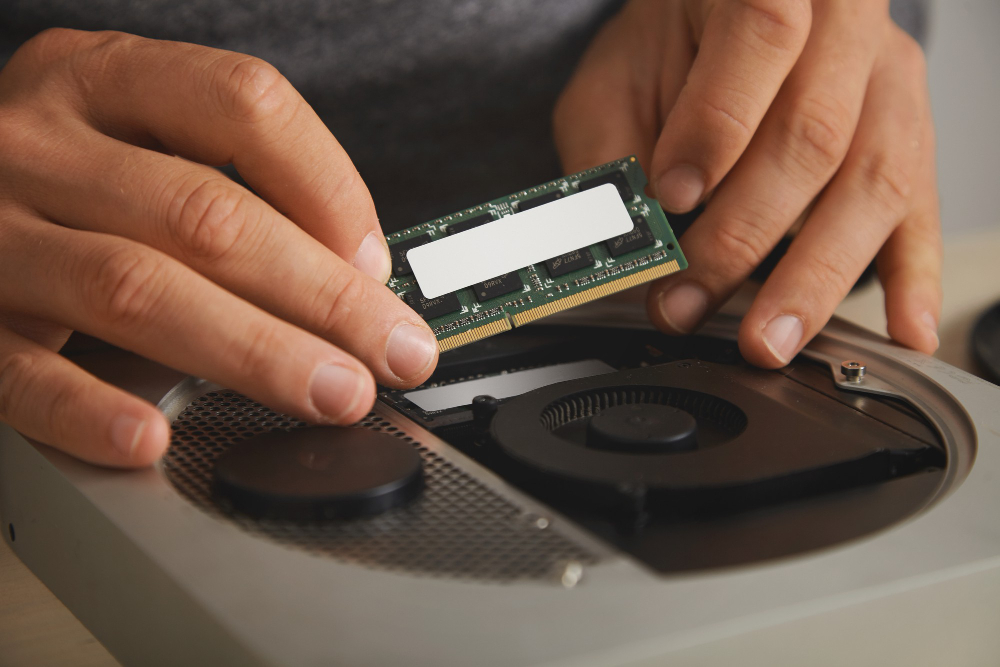
How to Know Which SSD is Compatible with My Laptop. Upgrading your laptop with an SSD (Solid-State Drive) is one of the best ways to boost its performance. But before making the leap, it’s essential to know which SSD is compatible with your laptop. There are various types of SSDs with different sizes, interfaces, and speed variations, and choosing the right one can be overwhelming. This guide will walk you through the steps to ensure you make the right decision.
Table of Contents
What is an SSD? How to Know Which SSD is Compatible with My Laptop
What is an SSD?
One kind of non-volatile storage device that stores data using flash memory is called a Solid State Drive (SSD). Unlike traditional HDDs, which use spinning magnetic disks and mechanical read/write heads, SSDs have no moving parts. This design enables SSDs to offer significantly faster data access speeds, lower power consumption, and enhanced durability.
Key Components of an SSD
An SSD consists of several essential components that work together to store and retrieve data efficiently:
- NAND Flash Memory: This is the primary storage medium in an SSD. It retains data even when the power is turned off, ensuring non-volatile storage.
- Controller: The controller manages data storage and retrieval, optimizing read and write processes for better performance.
- Cache (DRAM or SLC Cache): Some SSDs include a cache to temporarily store frequently accessed data, further improving speed.
- Interface (SATA, NVMe, PCIe, etc.): This determines how the SSD connects to the computer and affects its data transfer speed.
How Does an SSD Work?
Unlike HDDs that rely on spinning platters and read/write heads, SSDs use flash memory to store and retrieve data. Here’s how an SSD functions:
- Data is Stored in NAND Flash Cells: SSDs use NAND flash memory, where data is stored in electrical cells that retain information even when power is off.
- Data Access via the Controller: The SSD controller manages the movement of data within the drive, ensuring quick retrieval and storage.
- Parallel Processing: SSDs can access multiple memory cells simultaneously, unlike HDDs, which read data sequentially.
- Wear Leveling and TRIM: Modern SSDs use wear leveling to distribute write cycles evenly, prolonging their lifespan. The TRIM command helps maintain performance by clearing unused data blocks.

Advantages of SSDs Over HDDs
1. Speed and Performance
Speed is one of the biggest benefits of SSDs over HDDs. While HDDs typically offer speeds between 80-160 MB/s, SSDs can reach speeds of up to 7,000 MB/s, depending on the interface (SATA, NVMe, PCIe). This results in:
- Faster boot times
- Quicker application loading
- Enhanced overall system responsiveness
2. Durability and Reliability
Since SSDs have no moving parts, they are more resistant to physical shocks, vibrations, and temperature variations. This makes them ideal for laptops and portable devices.
3. Energy Efficiency
SSDs consume less power than HDDs because they do not require spinning disks. This leads to:
- Improved battery life in laptops
- Reduced heat generation
- Lower energy costs for data centers
4. Noise-Free Operation
Unlike HDDs, which produce noise due to spinning platters, SSDs operate silently, making them ideal for environments where minimal noise is preferred.
5. Compact and Lightweight
SSDs are available in various form factors, such as 2.5-inch, M.2, and U.2, making them compact and lightweight, suitable for ultra-thin laptops and compact PCs.
Types of SSDs
There are different types of SSDs based on form factors and interfaces. Selecting the ideal SSD for your requirements can be made easier if you are aware of these sorts.
1. SATA SSDs
- Interface: SATA III (6 Gbps)
- Speed: Up to 600 MB/s
- Common Form Factor: 2.5-inch
- Best For: Upgrading older computers and general-purpose use
2. M.2 SSDs
- Interface: SATA or NVMe (PCIe)
- Speed: 600 MB/s (SATA) to 7,000 MB/s (PCIe 4.0)
- Common Form Factor: M.2 2242, 2260, 2280, 22110
- Best For: Thin laptops, ultrabooks, and high-performance desktops
3. NVMe SSDs
- Interface: PCIe (PCI Express)
- Speed: 2,000 MB/s to 7,000 MB/s
- Common Form Factor: M.2, U.2, AIC (Add-in Card)
- Best For: Gaming, professional workstations, high-speed applications
4. PCIe SSDs
- Interface: PCIe (x4, x8, x16 lanes)
- Speed: Up to 7,000 MB/s or more
- Common Form Factor: AIC (Add-in Card), U.2, M.2
- Best For: Enterprise storage, high-performance computing

Factors to Consider When Buying an SSD
When purchasing an SSD, consider the following factors:
1. Storage Capacity
SSDs come in various capacities, including:
- 128GB – 256GB: Suitable for basic computing tasks
- 500GB – 1TB: Ideal for most users, providing ample storage
- 2TB – 4TB: Best for gaming, content creation, and professional use
2. Read and Write Speeds
Faster SSDs improve system performance. Look for SSDs with higher read/write speeds, especially if using them for gaming or professional workloads.
3. Endurance and Lifespan
SSD lifespan is measured in TBW (Terabytes Written). Higher TBW values indicate longer endurance. Consider this if you write large amounts of data regularly.
4. Compatibility
Ensure the SSD fits your device. Check for:
- Form Factor (2.5-inch, M.2, U.2, AIC)
- Interface (SATA, NVMe, PCIe)
- Motherboard and BIOS support
5. Price and Budget
SSDs are generally more expensive than HDDs, but prices have been decreasing. Choose an SSD that balances cost and performance for your needs.
Future of SSD Technology
The future of SSDs looks promising, with continuous advancements in speed, capacity, and reliability. Some emerging trends include:
3D NAND Technology: Increasing storage capacity while maintaining performance
PCIe 5.0 and PCIe 6.0 SSDs: Offering even faster speeds for next-generation computing
QLC (Quad-Level Cell) NAND: Increasing storage density and reducing costs
AI and Machine Learning Optimization: Enhancing SSD efficiency in data centers
Why Upgrade to SSD?
SSDs improve boot time, application loading speeds, and overall system responsiveness. If your laptop feels sluggish, switching to an SSD could give it a second life.

Types of SSDs Available in the Market
How to Know Which SSD is Compatible with My Laptop. There are different types of SSDs, each with distinct features that determine compatibility and performance. The three most common types are:
SATA SSDs
These are the most common and widely supported SSDs. They connect via the SATA interface, the same port used by traditional hard drives.
NVMe SSDs
Non-Volatile Memory Express (NVMe) SSDs provide faster data transfer speeds compared to SATA SSDs. They connect via the M.2 slot and are ideal for users who need high-performance storage.
PCIe SSDs
These SSDs use the PCIe (Peripheral Component Interconnect Express) interface, which offers faster data transfer rates than both SATA and NVMe. However, they are generally more expensive.
Checking Your Laptop’s Current Storage Configuration
Before purchasing an SSD, it’s important to know what kind of drive your laptop currently uses and what slots are available for an upgrade.
How to Identify the Type of Drive Installed in Your Laptop
To find out what type of drive your laptop is using, you can:
- Open the laptop and physically check the drive.
- Check your laptop’s documentation.
- Use software tools like Device Manager or Disk Management in Windows.
Software Tools for Drive Identification
Programs like CPU-Z or Speccy can help you identify your current storage setup without having to open your laptop.
How to Find Out What Type of SSD Slot Your Laptop Has
Laptops have different SSD slots, and knowing which one your device has is crucial to finding a compatible SSD.
Checking Manufacturer’s Specifications
Most laptop manufacturers provide a detailed specification sheet for each model. This information can often be found on the manufacturer’s website.
Using System Information Tools
Tools like “msinfo32” in Windows provide hardware details about your laptop, including storage slots.
Physically Checking Inside Your Laptop
If you’re comfortable, open the laptop and check if it has an M.2 slot or a space for a 2.5-inch SATA drive.

Understanding Size Compatibility
SSDs come in different physical sizes, and your laptop must be able to accommodate the SSD you choose.
2.5-Inch SSDs
These are the standard size for most SATA SSDs and fit in the same slot as a traditional hard drive.
M.2 SSDs
These are smaller and often used in thinner laptops. They can use either the SATA or NVMe interface.
PCIe SSD Size
PCIe SSDs vary in size, and it’s important to ensure your laptop has a slot that can accommodate them.
Interface Compatibility: SATA vs. NVMe
The interface determines the connection between the SSD and your laptop’s motherboard. It impacts speed and compatibility.
Differences in Performance
NVMe SSDs are much faster than SATA SSDs. However, not all laptops support NVMe, so it’s important to check your system’s specifications.
Understanding Backward Compatibility
Some NVMe slots are backward compatible with SATA SSDs, meaning you can install a slower SATA SSD in an NVMe slot, but the opposite isn’t true.
Power Consumption Considerations
While SSDs generally consume less power than HDDs, the type of SSD you choose can impact your laptop’s battery life.
SSD Power Ratings
SSDs have different power requirements, and selecting an SSD that aligns with your laptop’s power limits can improve battery life.
How Power Impacts Laptop Battery Life
NVMe SSDs, while faster, may consume more power than SATA SSDs, reducing battery life slightly.
Operating System Compatibility
Different operating systems handle SSD upgrades differently. Make sure your laptop’s OS supports the SSD you’re planning to install.
Windows
Windows automatically recognizes most SSDs, but it’s important to ensure you have drivers ready for installation.
macOS
If you’re upgrading a MacBook, check the compatibility of third-party SSDs, as some models have proprietary connectors.
Linux
Linux is generally SSD-friendly, but certain distributions may require specific drivers for NVMe SSDs.
Storage Capacity and Budget
When choosing an SSD, consider how much storage space you need and balance that with your budget.
Common SSD Sizes
SSDs are available in sizes ranging from 120GB to 4TB. A 500GB or 1TB SSD is usually a good balance between storage and cost.
Balancing Cost with Performance
NVMe SSDs are generally more expensive than SATA SSDs, so it’s important to consider whether you need the extra speed for your tasks.
Warranty and Reliability
When buying an SSD, make sure to check the warranty and reliability of the drive.
What to Look for in Warranty Terms
Most SSDs come with a 3- to 5-year warranty. Be sure to check the fine print on what’s covered.
SSD Lifespan Considerations
SSDs wear out over time, especially with heavy usage. Look for drives with high durability ratings for longer life.
Conclusion: Key Takeaways for SSD Compatibility
When upgrading your laptop’s storage, it’s important to consider the type of SSD, size, interface, and power consumption. By checking your laptop’s specifications and understanding the types of SSDs available, you can make an informed decision.
FAQ?
Can I use any SSD with my laptop?
No, not all SSDs are compatible with every laptop. You need to check the slot type, interface, and physical size.
What’s the difference between SATA and NVMe?
SATA is slower but widely supported. NVMe is faster but may not be compatible with older laptops.
How do I check if my laptop supports NVMe SSDs?
To check if your laptop supports NVMe SSDs, you can look up your laptop’s specifications on the manufacturer’s website, use system information tools like “msinfo32,” or physically check for an M.2 slot inside the laptop.
Is upgrading to an SSD worth it?
Yes, upgrading to an SSD is one of the most cost-effective ways to boost your laptop’s speed, responsiveness, and overall performance, especially if you’re transitioning from an HDD.
What happens if I install an incompatible SSD?
If you install an incompatible SSD, your laptop may not recognize it, or it might not fit in the slot physically. Always verify compatibility before purchasing to avoid issues.
2 thoughts on “How to Know Which SSD is Compatible with My Laptop”